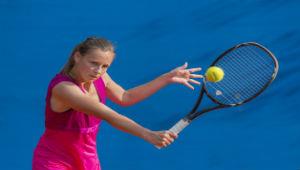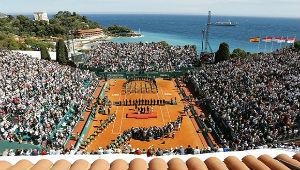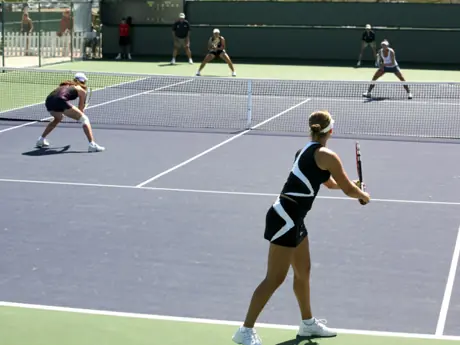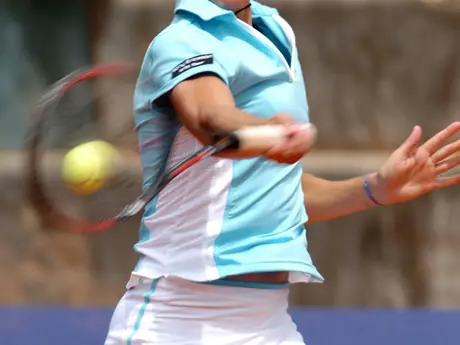
The winners seek information and mentally file away for future use every scrap of available data. More importantly, they see what works.
Most learning comes from experience, and the champions are alert. They concentrate intently on the task at hand, learn quickly from their failures and successes and adjust their behaviors accordingly. Information gleaned from reward and punishment immediately shapes future actions.
Champions acquire this sensitivity because they commit themselves so deeply to their tasks. Their high drive sharpens their senses. Wanting so badly to succeed opens their eyes. It focuses their attention and masses their powers of concentration. In this state they are remarkably perceptive.
In a word, they work "smart."
The Winner's Mind
by Allen Fox, Ph.D.
Conversely, the less successful are not perceptive and tend to make the same mistakes repeatedly, behaving as if there were no difference between reward and punishment.
Because their fears of failure make them shun commitment, they tread only on the surface of life. The task at hand does not fill their view-screens and their attentions wander. Their insecurities and self-protective impulses cloud their minds, and they see with half-closed eyes.
Not believing deeply in their own capabilities and only too willing to cast their fates to chance, they proceed blindly, making only the shallowest and most perfunctory efforts to understand the competitive scene confronting them.
In a word, they work "dumb."
Consider how great tennis players learn where and how hard to hit the ball in particular situations. They learn by trial and error.
For example, they may, in one situation, hit the ball to a certain spot and lose the point; later, in the same situation, they may hit the ball to a different spot and win the point.
They mentally record the results of these and thousands of other experiences and develop a feeling for which spots are advantageous and which are dangerous.
During competition they instinctively use this information to select the shot for each situation that provides the maximum payoff for the minimum risk. People like Andre Agassi and Serena Williams are able to choose with uncanny efficiency the highest percentage reply to any shot their opponents may hit. They never hit the ball one mile per hour harder nor one centimeter closer to the lines than necessary.
They develop this judgment by keeping their eyes open and adjusting their strategies in response to what they see. They are sensitive to what works, drawn to it like a shark to blood.
On the other hand, the vast majority of people seem largely oblivious to the lessons of success and failure and respond only to the grossest and most obvious examples. (Champions, by contrast, respond to the slightest nuance.)
I saw this in operation at my tennis camps. Each week during the summer nearly 100 young tennis hopefuls came to my camps at Pepperdine University. For the most part they were eager to hone their skills and improve their games.
My opening talk on strategy focused on the fact that at the lower skill levels of the game defense has the advantage over offense, and the person that hits the ball in the court the most is usually going to win. Lacking fine accuracy, the person hitting hard, close to the net and close to the lines takes too many risks and is going to lose. They all nodded in agreement.
Yet when they got on the court most of them did what they always had done -- hit the ball too hard, too close to the net and lines and made too many errors.
Their take on the situation was that hitting three out of four balls in the court was the best they could do. In reality, though, they needed to hit the ball in the court nine out of 10 times, and they could have done so if only they had hit the ball easier and farther away from the net and lines.
The few that understood this (and hit easier and more safely) missed less frequently, had a commanding competitive advantage and won almost all of their matches.
Somehow the majority did not respond to the evidence of their senses and continued to overhit, even though they lost again and again to the steadier players.
They called the steady players "dinkers," belittled their games and claimed that the "dinkers" would never get any better playing that way. (They sometimes even felt self-righteous about hitting hard, convinced that the steady players have adopted an inherently immoral style of play.)
In the process, they failed to adjust their games in accordance with their capabilities. Rather, they continued to hit too hard, miss, and lose.
Why did they do this, despite the evidence of their senses? They did so because the usual bugaboos of insecurity and fear of failure cloud their judgments.
It is, simply put, emotionally easier to just bang away at the ball and leave the outcome to fortune than it is to, in a controlled and thoughtful manner, keep the ball in the court. If you have a good day, you win; if you have a bad one, you lose – no emotional drama.
By contrast, playing consistently leads to long, stress-filled points. You go nose-to-nose with your opponent and the contest becomes an obvious battle of wills.
It gets personal, and winning requires emotional discipline and prolonged concentration. Unruly nerves and choking raise their ugly heads and must be overcome.
None of this is pleasant, so the average person dodges the situation. They subconsciously realize that if they scrutinize the scene too closely, they might have to take actions that they would rather avoid.
So they don't look, and they lose.
Thinking is Hard Work
In order to work "smart," the way champions do, you have to be constantly alert.
You have to continually take in and process information. In a word, you have to always be thinking about what you are doing, not, as is too often the case, mindlessly plodding through the motions on mental autopilot.
As they plug away on a task or practice a new skill, champions ask themselves questions like, "Is this the easiest way to do it?" "What are my weaknesses and how can I improve them?" "Why am I doing it this way instead of that way?"
They want to know everything about what they are doing so they can do it better. Their eyes and minds are unceasingly active and vigilant.
For example, when tennis champions practice, they constantly refine their techniques, and this requires mental as well as physical effort.
When working on their groundstrokes, great tennis players focus on getting into perfect position, preparing the shoulder turn early, watching the ball, and any other technical device that has proven helpful to them in hitting the shot better.
They concentrate intensely for hours at a time, attempting to rehearse the muscle memory involved in a near perfect stroke. Their goal is to make all motions correct and automatic for use in competition.
On the other hand, their less successful contemporaries may put in similar amounts of time on the practice courts and exert similar amounts of physical effort running around and hitting balls, but their minds are often elsewhere, hence their improvement per hour of court time is far less.
The less successful are mentally passive during practice, assuming that simply putting in the time and doing the physical work will make them better. Of course they do get better, but not better enough.
Most people habitually avoid mental exertion. Examples are commonplace. Watching television, which is a mentally passive activity, is more attractive to the masses than reading a book, which requires active mental participation.
The repellent aspect of exercising is more mental than physical. The mind has to force the body to work, and it is this, rather than the work itself that most people wish to shun.
Do you need proof? Recall the television ads for those belts that you wrapped around your midsection and which, supposedly, stimulated your abdominal muscles with pulses of electricity and caused them to contract.
You saw beautiful young men and women with shapely cut abdominal muscles on these programs, claiming to have gotten their figures by relaxing and watching their favorite television shows while the belts stimulated their muscles. (It seemed too good to be true, and, unfortunately, it was).
But what was the charm of the belts? Your abdominal muscles still had to contract and work in order to become shapely and strong, just as they do with sit ups and crunches. The difference was only in what drove the muscles to work.
With the belts, your muscles were driven by external electricity whereas with normal exercise, the electricity had to be supplied by your brain. And people were willing to pay plenty to escape having to use their brains.
To be successful you must work towards your goals with your eyes wide open. Hard work is helpful, but not enough.
Lowering one's head and simply grinding forward is apt to be inefficient. You must make a special effort to work with your head up -- alert and concentrating so as to soak up and assimilate every bit of available information.
Absorb and employ ALL information so that you work not just hard, but "smart."
 See more tennis tips or find tennis camps near you.
See more tennis tips or find tennis camps near you.
Allen Fox, Ph.D. is a former NCAA champion, Wimbledon quarter-finalist and a three-time member of the U.S. Davis Cup team. Dr. Fox also coached the Pepperdine tennis team to two NCAA finals. He currently lectures on sports psychology and is the author of several books on the mental side of competition








Discuss This Article